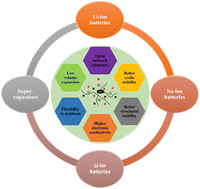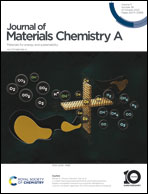A review of silicon oxycarbide ceramics as next generation anode materials for lithium-ion batteries and other electrochemical applications
Abstract
Lithium-ion batteries (LIBs) are the energy storage system of choice for the electrification of transportation and portable electronics. They are also being actively considered to meet the need to store electricity produced by renewable sources which tend to produce electricity intermittently. In commercial LIBs, graphite is the most common anode material. However, its theoretical specific capacity (372 mA h g−1) is limited. A search for alternatives led to the development of Si anodes due to their extremely high theoretical specific capacities (4200 mA h g−1). However, their commercial viability is limited due to their high volumetric expansion (more than 300%), which results in capacity fading during cycling. Silicon oxycarbide (SiOC) materials, which are synthesized using a polymer-derived ceramic (PDC) route, have been investigated as a substitute anode material for crystalline Si-based anodes. The specific capacity of these SiOC materials ranges from 200–1300 mA h g−1. Furthermore, these SiOCs are tailorable to meet the needs of electrochemical applications due to their versatile synthesis routes. Moreover, the amorphous nature of these materials and their micro–mesoporous structure make them capable of accommodating large strains when charged or discharged. In this review, we discuss the various factors that influence SiOCs' electrochemical performance, storage mechanisms, and recent developments. SiOC anodes suffer from low electrical conductivity, low Coulombic efficiencies, large hysteresis, and high first-cycle losses. Several techniques, such as employing nanoparticles, prelithiation, and using thin-film geometries, have been employed to overcome these limitations. The literature on these approaches is also reviewed. A number of recent studies have also examined the use of SiOC in lithium-tin anodes, sodium-ion batteries, and supercapacitors. The status of these developments and the challenges associated with the wide-scale use of SiOC is presented.

- This article is part of the themed collections: Journal of Materials Chemistry A Recent Review Articles and #MyFirstJMCA


 Please wait while we load your content...
Please wait while we load your content...